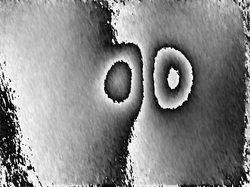Laser Shearography
Laser Shearography is a rapid yet sensitive, non-contact method of NDT that can quickly inspect a structure to determine
the extent of subsurface anomalies such as disbonds and voids. The shearography camera uses laser light to detect weak areas of the structure. A sheared reference image is taken and stored. The structure is stressed slightly and images taken during and after stressing are compared with the stored original. Any relative displacement of the surface is depicted as fringes which, due to the opto-computer arrangement, are closely related to lines of iso-strain. They therefore indicate by their concentration, the strength of the bond beneath. This process is practically real time, with results available within seconds.
We have extensive experience in the application of this technology to composite materials in the marine, aerospace,automotive and civil engineering sectors of industry. We work closely with equipment manufacturers to ensure that the technology is developing and supporting new and emerging inspection challenges as well as being constructed to successfully perform in demanding inspection environments. To ensure consistency of application the inspection service supplied meets the requirements of BS EN 4179 and SNT TC IA.
the extent of subsurface anomalies such as disbonds and voids. The shearography camera uses laser light to detect weak areas of the structure. A sheared reference image is taken and stored. The structure is stressed slightly and images taken during and after stressing are compared with the stored original. Any relative displacement of the surface is depicted as fringes which, due to the opto-computer arrangement, are closely related to lines of iso-strain. They therefore indicate by their concentration, the strength of the bond beneath. This process is practically real time, with results available within seconds.
We have extensive experience in the application of this technology to composite materials in the marine, aerospace,automotive and civil engineering sectors of industry. We work closely with equipment manufacturers to ensure that the technology is developing and supporting new and emerging inspection challenges as well as being constructed to successfully perform in demanding inspection environments. To ensure consistency of application the inspection service supplied meets the requirements of BS EN 4179 and SNT TC IA.
The photo above shows an inspection taking place using our Dantec Q810 Vacuum hood system. The pattern on the computer screen on the left is a typical speckle pattern formed under the hood. This can also be viewed on the screen that is mounted directly to the vacuum hood allowing the operator to move the hood quickly around the structure to be tested. Several screen shots can be taken a minute meaning this is a very efficient method of inspection. Where anomolies are apparent then that area can be investigated more closely although this inevitably slows down the investigation.
We also have a Dantec Q800 free standing laser camera. This system uses thermal stressing from a heat gun which without the vacuum system is rather smaller and therefore portable. As it doesn't need to achieve a seal like the vacuum hood it can also inspect right to the edge of components.
We also have a Dantec Q800 free standing laser camera. This system uses thermal stressing from a heat gun which without the vacuum system is rather smaller and therefore portable. As it doesn't need to achieve a seal like the vacuum hood it can also inspect right to the edge of components.

The image on the left shows a typical set of fringes from a 'clean' piece of material.

This image shows where a disbond anomoly is present. The lines of iso strain, fringes, congregate around the anomoly highlighting it's existence. The deflection of the anamoly only needs to be as little as 50 microns for the laser pattern to pick it up. Stressing of the piece to achieve this deflection is normally via vacuum or heat and very little of either is required to produce this small amount of deflection.


